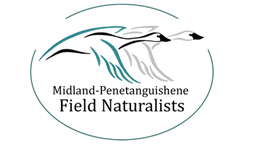Event Report – 2025-04-06 – Windlee Farms
The Midland-Penetanguishene Field Naturalists held their first outing of 2025 on Sunday morning Apr. 6, 2025 at the Windlee Farms Maple Syrup Open House at their location on Baseline Rd. just north of Balm Beach Rd. west of Midland.
Here’s MPFN President Bob Codd’s trip report:
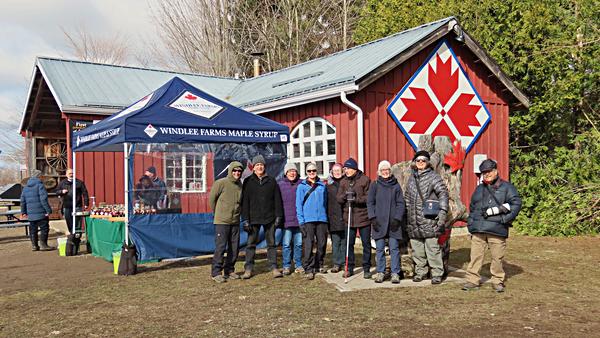
Crowds were already beginning to gather when I arrived at Windlee Farms. I was uncharacteristically early and I got a great parking spot, close to the entrance. The Windlee Farms Open House is a hugely popular local event, attracting hundreds of visitors from near and far. It’s not often that one of the Field Nats’ outings has to share the stage with another organization but this one was a perfect fit for our nature club.
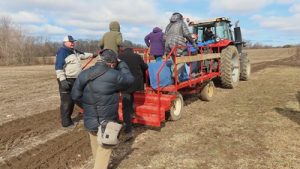 The event was all about maple syrup, a truly natural Canadian product that humans have been gathering and processing for millenia. I honestly didn’t think that there was much new to learn about maple products but after a short ride in a hay wagon to the sugar bush I quickly discovered that I was wrong. We learned how to identify the sugar maple from its leafless twigs and heard about Windlee Farms’ efforts to keep syrup production sustainable. They use a single tap per tree and rotate the placement around the trunk each year to keep them healthy.
The event was all about maple syrup, a truly natural Canadian product that humans have been gathering and processing for millenia. I honestly didn’t think that there was much new to learn about maple products but after a short ride in a hay wagon to the sugar bush I quickly discovered that I was wrong. We learned how to identify the sugar maple from its leafless twigs and heard about Windlee Farms’ efforts to keep syrup production sustainable. They use a single tap per tree and rotate the placement around the trunk each year to keep them healthy.
I was surprised to learn that Wild Turkeys are the mortal enemy of syrup producers. That’s not something that springs to mind when thinking about syrup production. Evidently their razor sharp bills can and often do, slice clean through the lines that are used to collect the sap. Their defence against this is to set up an automatic feeder in a field well away from the sugar bush. By providing corn for the Turkeys they hope to keep them out of the woods and away from the collection system. Unfortunately this has limited effect on another threat, squirrels. We were told that they’re even more insidious. Anyone who feeds birds will know how persistent and relentless these rodents can be. Their sharp teeth can create pinholes in the lines that can reduce vacuum pressure that the collection system requires. These small holes are a challenge to locate and repair.
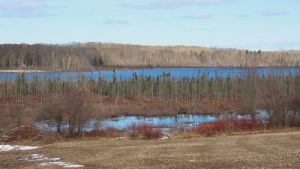 From here we headed out on a more traditional naturalist pursuit and we made our way down a gently sloping field, skirting the edge of the sugar bush towards Lalligan Lake. Its blue waters could be seen in the distance, beckoning us in the windy sunshine. Damage from the recent ice storm was apparent but surprisingly limited compared to the devastation we’d seen elsewhere. Sparrows and Chickadees accompanied us on our route. We would never reach the actual lake as it’s surrounded by a boggy wetland that provides habitat for migrating ducks and geese. Canada Geese were already nesting here and migrating ducks were feeding and resting in the wetland. We scoured the area for birds and wildlife. Deer tracks could be seen in the soft soil although we never laid eyes on one. In a buzzy whirl of wings we inadvertently flushed a Woodcock. It was too quick for photos or even a decent view. We had to rely on some solid research by Ken to determine precisely what we’d seen.
From here we headed out on a more traditional naturalist pursuit and we made our way down a gently sloping field, skirting the edge of the sugar bush towards Lalligan Lake. Its blue waters could be seen in the distance, beckoning us in the windy sunshine. Damage from the recent ice storm was apparent but surprisingly limited compared to the devastation we’d seen elsewhere. Sparrows and Chickadees accompanied us on our route. We would never reach the actual lake as it’s surrounded by a boggy wetland that provides habitat for migrating ducks and geese. Canada Geese were already nesting here and migrating ducks were feeding and resting in the wetland. We scoured the area for birds and wildlife. Deer tracks could be seen in the soft soil although we never laid eyes on one. In a buzzy whirl of wings we inadvertently flushed a Woodcock. It was too quick for photos or even a decent view. We had to rely on some solid research by Ken to determine precisely what we’d seen.
Having searched the wetland for wildlife we headed towards another feature that’s common on farms in our region, a large dry stone wall. These features fascinate me. In the past I’ve made the mistake of assuming that these stone walls were the product of machinery. In fact these predate mechanization and are the result of human ingenuity, hard work and literal horsepower. I won’t attempt to describe the process. David Hawke, one of our favourite presenters, does a much better job of explaining the process than I could hope to.
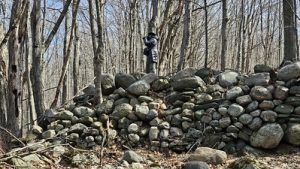 These structures provided wonderful photo opportunities. The outing party couldn’t resist scaling them and clambering around the stacked up boulders. No real nature sightings arose here but we did discover a spring loaded device of some sort, assumedly a trap or snare of some type. It was anchored to a tree with a steel cable and although I don’t believe we ever discerned its true purpose it was a genuine curiosity and the source of much speculation.
These structures provided wonderful photo opportunities. The outing party couldn’t resist scaling them and clambering around the stacked up boulders. No real nature sightings arose here but we did discover a spring loaded device of some sort, assumedly a trap or snare of some type. It was anchored to a tree with a steel cable and although I don’t believe we ever discerned its true purpose it was a genuine curiosity and the source of much speculation.
The stone wall marked the beginning of our return to the farmstead and the festivities taking place there. The grounds are meticulously maintained and I was drawn to a wooden silo that was attached to a very neat barn. Constructed of wooden planks and bound together with large steel cables it seemed like something straight out of history. I wasn’t the only one to appreciate this structure. An Eastern Phoebe made use of this lofty perch, hawking unseen flying insects on the wing. Phoebes are our earliest returning migrant flycatchers. In the below freezing sunshine it was difficult to imagine which hardy insects it was catching. Fortunately the Phoebe didn’t require our comprehension to enjoy its lunch. It was still singing and hunting as we made our way back to the main event.
By now a large crowd was assembled. Ken urged us towards Tom Goldsmith of Riverside Raptor Rescue. Many of us will remember him from his days with the Wye Marsh Wildlife Centre. He had with him a Peregrine Falcon and a Red-tailed Hawk. I am absolutely not a fan of captive birds, especially these impressive birds of prey. But these two birds, along with all the others that this organization rescues, were destined to be released into the wild.
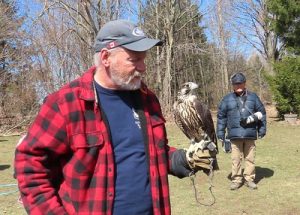 Riverside Raptor Rescue does just as the name suggests. They rescue and rehabilitate birds of prey. Those who do this work are the people whom I admire most. Organizations like Riverside Raptor Rescue, The Owl Foundation and Shades of Hope are amongst the very few who work to undo the harms done by our modern human centered world. They give these creatures a second chance to live the lives they were intended to. I don’t have proper words to express my appreciation for this vital work. All I could do was to voice my gratitude over and over. The world needs people like Tom and as our human population expands relentlessly, the need will become far greater.
Riverside Raptor Rescue does just as the name suggests. They rescue and rehabilitate birds of prey. Those who do this work are the people whom I admire most. Organizations like Riverside Raptor Rescue, The Owl Foundation and Shades of Hope are amongst the very few who work to undo the harms done by our modern human centered world. They give these creatures a second chance to live the lives they were intended to. I don’t have proper words to express my appreciation for this vital work. All I could do was to voice my gratitude over and over. The world needs people like Tom and as our human population expands relentlessly, the need will become far greater.
The backstory on the Peregrine Falcon is fascinating in itself. Tom believes that it was a captive bird that had been released into the wild. It was completely unprepared to fend for itself and quickly found itself in the caring hands of the good folks at Shades of Hope. Riverside Raptor Rescue taught the Falcon the life skills that it will need to to survive in the wild. Its fate is now in the hands of government wildlife officials, a rather disconcerting thought. As this Peregrine Falcon is not a truly wild individual, the decision on its suitability for release is in the hands of bureaucrats. Tom Goldsmith says the bird is ready and deserves to live its life in freedom. We can only hope that the government sees it that way too.
This organization is not well known. In fact I hadn’t heard of them before. Riverside Raptor Rescue has a gofundme page where you can donate to their indispensable work. If you want to help these majestic birds of prey, donating to their efforts is a great way to do it. Riverside Raptor Rescue GoFundMe Page
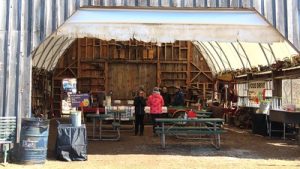 We’d reached the end of the outing but there were still the attractions of the open house to hold our interest. I tried hard to resist their sugary temptations and managed to restrain myself from gorging on their pancake breakfast. As I was heading to the car, I succumbed to the allure of maple candies and I bought an assortment of them – “for my wife.”
We’d reached the end of the outing but there were still the attractions of the open house to hold our interest. I tried hard to resist their sugary temptations and managed to restrain myself from gorging on their pancake breakfast. As I was heading to the car, I succumbed to the allure of maple candies and I bought an assortment of them – “for my wife.”
Our faithful sighting recorder couldn’t be with us this morning and it fell to me to document our non-avian observations. Fortunately for me, not much is growing so early in the season.
Here is a link to the eBird checklist of all the birds we’d seen.
MPFN at Windlee Farms E-Bird Checklist
In addition to birds we also observed:
Maple trees!
The low growing rosettes of Common Mullein
The remnants of Evening Primrose, still standing despite the crushing weight of snow.
Coltsfoot or Tussilago farfara. A non native plant that blooms very early and that provides a welcome glimpse of colour after a seemingly endless winter.
I want to acknowledge and thank Windlee Farms for organizing this event and providing such an inspiring venue. I’d also like to thank Riverside Raptor Rescue and Tom Goldsmith for sharing an eye to eye encounter with a spectacular Peregrine Falcon. Most of all I want to thank all the Field Nats who braved the chilly sunshine and who made the outing the success that it was.
Until next time!
Cheers
Bob Codd
And here’s a link to a Flickr album with photos of the outing. Thanks to our photographers Bob Codd and Ken MacDonald. MPFN at Windlee Farms Photo Album
Keep checking your emails for our next outing.
